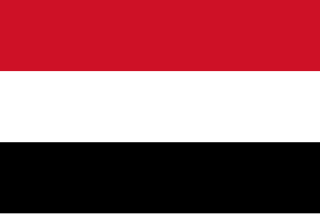
Yemen, officially the Republic of Yemen, is a country in West Asia. Located in southern Arabia, it borders Saudi Arabia to the north, Oman to the northeast, the Red Sea to the west, and the Indian Ocean to the south, sharing maritime borders with Eritrea, Djibouti and Somalia across the Horn of Africa. Covering roughly 455,000 square kilometres, with a coastline of approximately 2,000 kilometres, Yemen is the second largest country on the Arabian Peninsula. Sanaa is its constitutional capital and largest city. Yemen's estimated population is 34.7 million, mostly Arab Muslims. It is a member of the Arab League, the United Nations, the Non-Aligned Movement and the Organisation of Islamic Cooperation.

The Republic of Yemen is divided into twenty-one governorates (muhafazah) and one municipality (amanah):
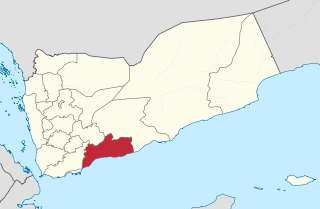
Abyan is a governorate of Yemen. The Abyan region was historically part of the Fadhli Sultanate. It was a base to the Aden-Abyan Islamic Army militant group. Its capital is the city of Zinjibar. This governorate is noted for its agriculture, in particular the cultivation of date palms and animal husbandry.
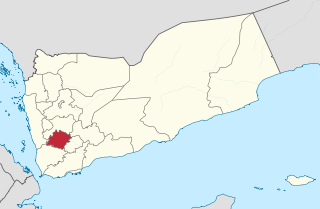
Ibb is a governorate of Yemen. It is located in the inland south of the country with Ta'izz Governorate to the southwest, Ad Dali' Governorate to the southeast, Dhamar Governorate to the north, and short borders with Al Bayda' Governorate to the east and Al Hudaydah Governorate to the west. It has an area of 5,344 km² and a population estimated at around 1,665,000 in 2004, making it the most densely populated governorate in Yemen outside of San'a city. It is the third largest province in Yemen.
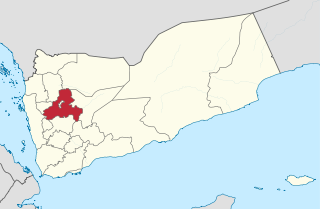
Sanaa, also spelled San'a' or Sana, is a governorate of Yemen. Its capital is Sanaa, which is also the national capital. However, the city of Sanaa is not part of the governorate but instead forms the separate governorate of Amanat Al-Asemah. The Governorate covers an area of 13,850 km2 (5,350 sq mi). As of 2004, the population was 2,918,379 inhabitants. Within this place is Jabal An-Nabi Shu'ayb or Jabal Hadhur, the highest mountain in the nation and the Arabian Peninsula.
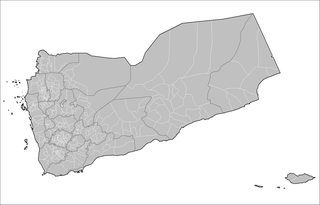
The administrative division of Yemen consists of two main divisions. There are 22 governorates, including the capital Sana'a and Socotra Archipelago. The 22 governorates are then divided into 333 districts, subdivided into 2,210 sub-districts, and then into 38,284 villages.

The Houthi insurgency, also known as the Houthi rebellion, the Sa'dah Wars, or the Sa'dah conflict, was a military rebellion pitting Zaidi Shia Houthis against the Yemeni military that began in Northern Yemen and has since escalated into a full-scale civil war. The conflict was sparked in 2004 by the government's attempt to arrest Hussein Badreddin al-Houthi, a Zaidi religious leader of the Houthis and a former parliamentarian on whose head the government had placed a $55,000 bounty.
Judeo-Yemeni Arabic is a variety of Arabic spoken by Jews living or formerly living in Yemen. The language is quite different from mainstream Yemeni Arabic, and is written in the Hebrew alphabet. The cities of Sana'a, Aden, al-Bayda, and Habban District and the villages in their districts each have their own dialect.

The following outline is provided as an overview of and topical guide to Yemen:

Sanaa, officially the Sanaa Municipality, is the capital and largest city of Yemen. The city is the capital of the Sanaa Governorate, but is not part of the governorate, as it forms a separate administrative unit. According to the Yemeni constitution, Sanaa is the capital of the country, although the seat of the Yemeni government moved to Aden, the former capital of Democratic Yemen, in the aftermath of the Houthi occupation. Aden was declared the temporary capital by then-president Abdrabbuh Mansur Hadi in March 2015.
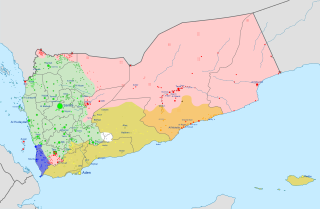
The Al-Qaeda insurgency in Yemen is an ongoing armed conflict between the Yemeni government, the United States and their allies, and al-Qaeda-affiliated groups in Yemen. It is a part of the Global War on Terror.

The Southern Movement, sometimes known as the Southern Separatist Movement, or South Yemen Movement, or Aden Movement, and colloquially known as al-Hirak, is a political movement and paramilitary organization active in the south of Yemen since 2007, demanding secession from the Republic of Yemen and a return to the former independent state of South Yemen. At present, its best-known political offshoot, the Southern Transitional Council led by Aidarus al-Zoubaidi, is the de facto leadership across many provinces of the south.
Amd District is a district of the Hadhramaut Governorate, Yemen. As of 2021, the district had a population of 31,102 inhabitants.
Sayun District is a district of the Hadhramaut Governorate, Yemen. As of 2003, the district had a population of 102,409 inhabitants.
Shibam District is a district of the Hadhramaut Governorate, Yemen. Its capital is the town of Shibam, famous for its mudbrick-made tower houses and known as the "Manhattan of the desert". During the Yemen Civil War, the city suffered some damage.

Zamakh wa Manwakh District is a large district of the Hadhramaut Governorate, Yemen. It is one of the largest districts in Yemen. As of 2021, the district had a population of 2,333 inhabitants.
Dhi As Sufal District is a district of the Ibb Governorate, Yemen. As of 2003, the district had a population of 163,019 inhabitants.

On 26 March 2015, Saudi Arabia, leading a coalition of nine countries from West Asia and North Africa, launched a military intervention in Yemen at the request of Yemeni president Abdrabbuh Mansur Hadi, who had been ousted from the capital, Sanaa, in September 2014 by Houthi insurgents during the Yemeni Civil War. Efforts by the United Nations to facilitate a power sharing arrangement under a new transitional government collapsed, leading to escalating conflict between government forces, Houthi rebels, and other armed groups, which culminated in Hadi fleeing to Saudi Arabia shortly before it began military operations in the country.
On 15 May 2016, a suicide bombing in the southern Yemeni port city of Mukalla, the capital of the Hadhramaut province, killed at least 47 police and injured over 60. The bombing was preceded by an attack, where 15 Yemeni troops were killed in attacks on army positions outside Mukalla. ISIL said, one of its militants blew up a vehicle, packed with explosives, in an army base in the Khalf district at the city's eastern outskirts.
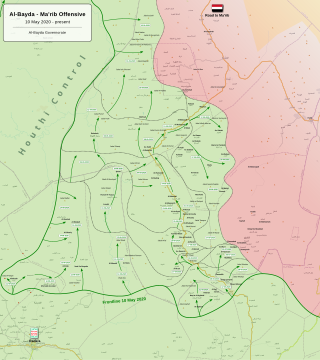
The Al Bayda offensive began in late July 2020 with the restart of military operations by Houthis forces in Al Bayda Governorate, during the Second Yemeni Civil War against forces of Al-Qaeda in Yemen, the Islamic State in Yemen and military forces loyal to the Government of Abd Rabbuh Mansur Al-Hadi.












